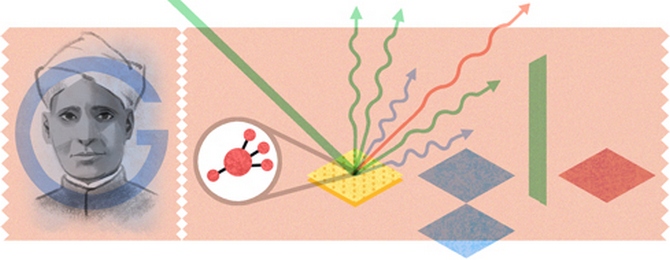
On what would have been CV Raman's 125th birthday, the search engine giant pays its tribute to India's Nobel Prize-winning physicist.
Sir Chandrasekhara Venkata Raman, better known as CV Raman, has been immortalised on engine giant Google's homepage with a doodle.
It was Raman, born on November 7, 1888, who discovered that on travelling through a transparent material, some of the deflected light changes in wavelength.
The discovery that led him to win the Nobel in 1930.
Born in Thiruvanaikaval, Trichinopoly in the Madras Presidency, CV Raman was the second of five children to R Chandrasekhara Iyer and Parvati Ammal (also known as Saptarshi Parvati).
Having moved to Visakhapatnam, Raman studied at the St Aloysius Anglo-Indian High School before entering the Presidency College in Madras at 13 in 1902 where his father taught mathematics and physics.
Two years later he completed his Bachelor of Arts degree with a gold medal in physics.
In 1907, he earned his master's degree with distinction.
Even though he was a keen scientist, there were few career opportunities in the field at the time. So, eventually he took the financial civil service exam and went to work for the government as an Assistant Accountant General continuing to carry out experiments at the Indian Association for the Cultivation of Science at Calcutta.
Meanwhile he had also begun to become a public figure of sorts reaching out to the masses with his lectures on popular science.
When in 1917, the University of Calcutta offered him the Palit Chair of Physics, he happily let go off his highly-paid civil service job to devote himself to what he loved the most -- science.
The germ of the idea on which he would work in the years to follow and one which would eventually win him the Nobel first occurred to him while he was travelling from England to India in 1921 by boat.
It was on this trip that he began considering why the colour of the sea was blue and eventually began working on a line of research that would eventually lead him to the discovery of the scattering effect that is now known as the Raman Effect.
Raman's discovery disproved the theory of Lord Rayleigh who suggested that the colour was merely a reflection of the sky.
It wasn't long before chemists began using Raman spectroscopy for chemical analysis. In 1929 he was knighted by the British Government and in the following year he received the Nobel Prize in Physics.
Eventually, he became the director of the Indian Institute of Science and after his retirement established the Raman Research Institute in Bengaluru where he served as director till he passed away on November 21 1970.
It is in his honour that the Government of India celebrates Science Day every year on February 28, the day he led experiments at the IACS leading to the discovery of the Raman Effect.